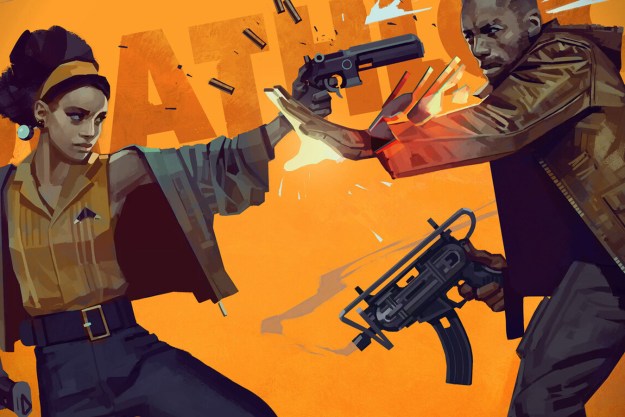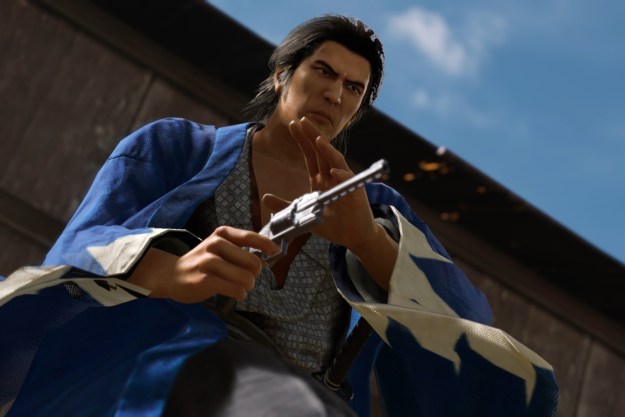
“Like a Dragon: Ishin's timeless story and accessibility options make up for some of its outdated gameplay.”
- Timeless story
- Kyo is a great location
- Charming substories
- Welcome accessibility options
- Inconsistent visual enhancements
- Dated combat
There’s a quirky series of substories in Like a Dragon: Ishin! centered around “Ee Ja Nai Ka,” a catchy social protest dance that’s popping up all over the town of Kyo. The townsfolk are basically chanting “Why Not?” to those in power during a time when Japan’s caste system and corruption are at their worst, urging them to make things better. They have to fight those existing power structures, as well as bad actors taking advantage of the protests to slip in their own nefarious agendas. Mixing the series’ trademark humor, heart, and action, it follows protagonist Sakamoto Ryoma, who slowly sees how this small action can make a big difference when one’s reason for doing the “Ee Ja Nai Ka” comes from the right place. It’s the defining subquest of a game that’s about change — one that just so happens to come as part of a remaster launching at an inflection point for the series.
The mainline Like a Dragon series is transitioning from an action-brawler to a turn-based game, its name in North America is changing from Yakuza to Like a Dragon, and some of developer RGG Studios’ key leaders have left and handed leadership over to a new generation. We now must wait and see if these changes were made out of love for Like a Dragon, or if these decisions will expose themselves as a mistake.
Even if this remaster of a spinoff set in 1800s Japan doesn’t do a lot to change itself from its initial release, for better and worse, Like a Dragon fans will still recognize all of the hallmarks of the series they know and love within Ishin, especially if they haven’t played it before. Its age has a way of showing through its remastered sheen, but the power of subquests like Ee Ja Nai Ka and the main narrative make this an adventure worth checking out now that it’s out in the West for the first time.
The cost of revolution
Although the series’ identity is historically tied to Japan’s modern-day crime scene, Ishin proves the series’ trademark action and earnest storytelling work no matter what era it’s set in. Ishin takes place in 1867, during Japan’s regime-changing Bakumatsu era, and stars Sakamoto Ryoma, a character resembling former Like a Dragon series protagonist Kazuma Kiryu. At the start of the story, Ryoma and his brother, Takechi, are part of the Tosa Loyalist Party, who recognize that times are changing and want to revolutionize Japan, ridding it of the staunch class system that punishes those without power.
Ishin is not just about what inspires political change; it’s interested in who incites social movements and why.
After Ryoma’s mentor is murdered, this effort is turned on its head as he pivots and instead tries to track down the man who killed his mentor under the new identity of Saito Hajime. Ultimately, this forces Ryoma away from his brothers and into the Shinsengumi, a group of samurai that technically works for the Shogun, but has country-changing political aspirations of its own. Ishin is not just about what inspires political change; it’s interested in who incites social movements and why.
If you enjoyed the political musings of Andor, you’ll find similar intriguing themes here. Although Ishin meanders a bit in its middle as it introduces a lot of characters (like most Like a Dragon titles do), it excels when its in full swing, deftly highlighting the dark side of how people choose what to sacrifice to achieve social change. The story inspects how noble social movements can be co-opted by grifters looking for what’s best for them and how political fighting can change people’s identities metaphorically and literally.

Ishin asks if it’s possible to make positive changes without abandoning what you love. Even though its set in the 1800s and was first released in 2014, it’s chillingly more relevant than ever. Its themes and subject matter are universal and understandable, even if its setting is a very distinct period of Japanese history that most Westerners only know the whitewashed version of. Plus, there’s a helpful glossary option in many cutscenes that you can use for reference if you forget the difference between the Bakufu and the Shinsengumi.
Like a Dragon is one of the most socially aware and thoughtful game series out there. If you enjoy a good political thriller story full of Like a Dragon’s quirky characters, shocking twists and betrayals, and lengthy monologues backed up by enthralling Japanese voice acting (there’s no English dub here), then Ishin will check off all the right boxes for you. Anyone can appreciate Ishin’s rerelease for finally localizing this story so anyone can enjoy it.
Kyo calls
On the gameplay front, the idea of change asserts itself more subtly when looking at the original release and its remaster treatment. Ishin itself features the same setup Like a Dragon games are known for. Most of the story takes place within one city, which players are free to explore between missions, visiting shops, eating food from vendors, and completing substories and minigames that contain some of the game’s quirkiest content along the way.
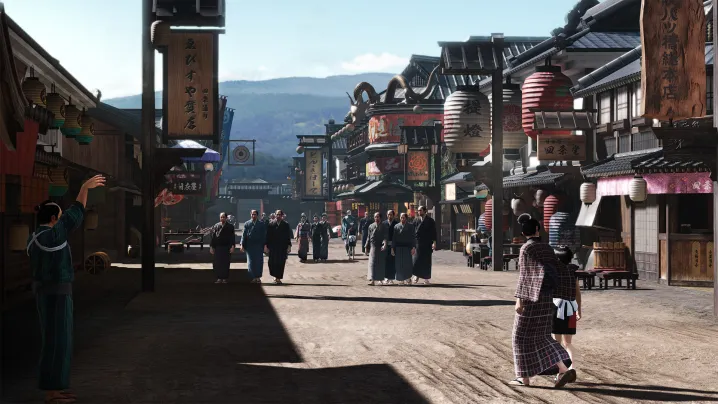
RGG Studios does a fantastic job of making its cities feel believable and lived in, and Ishin’s Kyo setting is no different. By the end of this lengthy adventure, I’d explored every corner of this major city, learning about its culture, food, and people. Substories vary from heartfelt ones about a debt collector helping the disadvantaged people of Kyo to silly ones where Ryoma tries to eloquently reason with a dog to stop barking. For those who are a bit tired of exploring Kamurocho again and again, Kyo provides a nice change of pace.
Kyo never feels quite as refined in its design as Kamurocho, though, likely because this is the only game it’s been featured in. Only one path from the north to the south of Kyo exists, so you’ll be retreading the same winding passageway a lot. Alleys don’t interconnect, nor do they hide enticing secrets quite as well as the games with a modern setting do. Still, I knew the city’s layout by heart by the end, something few games with open worlds can achieve.
Bringing a gun to a swordfight
Of course, Kyo’s various locales also serve as the backdrop for over-the-top fights. Most often, it’s Ryoma versus loyalists or rogue samurai and ronin trying to take advantage of others with their skills and power. Ishin’s combat is still built around pulling off combos to build up Heat that the player can spend on special, powerful abilities in certain situations. However, the “Brawler” hand-to-hand fighting typically seen in Like a Dragon games is only one of four combat styles in Ishin.

Weapons play a much more prominent role within Ishin’s other combat styles, with Swordsman allowing the player to be deadly with a blade up close, Gunman giving players the skill to shoot enemies from a distance, and Wild Dancer being a mixture of the two. I liked to stay in the Gunman stance, chipping off as much health as possible from a distance before enemies got close and I could defeat them with a Swordsman Heat Action.
Although the weapons focus gives this game’s combat a different flair, its combat also shows its age. If you’ve only played recent Like a Dragon games, fights will feel slower-paced and stiffer here. Animations and Heat Actions aren’t as flashy, and using a gun from a distance doesn’t leave the same impact as a powerful punch can. The UI also leaves a bit to be desired; in particular, constantly pausing the game to switch ammo types in the Gunman stance is annoying.
As a simple remaster, Ishin can’t do much to change the basics.
RGG Studio has made many action games since Like a Dragon: Ishin’s initial release, and combat has only gotten a little smoother, fast-paced, bombastic, and refined with each entry. While Ishin‘s increased focus on weapons is technically a big change from the series’ standard formula, its core feeling remains unchanged from nearly a decade ago. As a simple remaster, Ishin can’t do much to change the basics, though two new systems try to add some spice to combat.
Accessible changes
Trooper Cards are a new system that lets players equip three extra powerful abilities for each stance. These come in the form of cards, each of which has unique attributes and can be leveled up the more players use it. You can even recruit some enemies you fight via this system, which adds more meaning to random encounters. However, this system is somewhat undermined if you download the free special guest Trooper Cards featuring people like Rahul Kohli and Kenny Omega, which are extremely powerful and can be equipped to the two most useful styles.
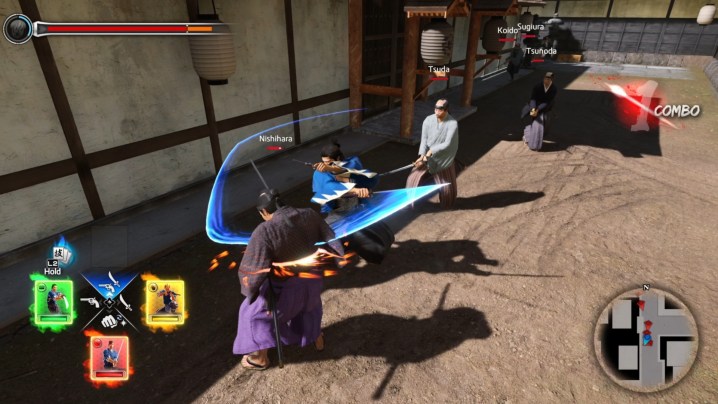
What I appreciated more was all of the new accessibility options. From Automatic Heat Actions and Special Moves to Simplified Combo Attacks, Ishin gives a bunch of options for anyone struggling with the game’s combat. One important thing modern remasters and remakes can do is add accessibility options to enable more people to experience great games as seamlessly as possible. This is the most crucial change (or addition) that this remaster makes for the series, and I hope to see all of these accessibility options in the upcoming Like a Dragon Gaiden: The Man Who Erased His Name.
While the Trooper Cards and accessibility options are new, they don’t change or redefine the core of the combat. Make no mistake, experiencing this Western release of Ishin feels like playing a refurbished 2014 game rather than the latest entry in the long-running series, even though it’s now more accessible than ever.
A noble piece of Like a Dragon history
Ishin‘s visual overhaul is noticeable, if imperfect. At some moments, the change to Unreal Engine 4 pays off with beautiful, highly detailed outdoor environments. On the flip side, many indoor locations look dated and feature poor lighting, which stands out alongside awkward facial animation during frequent in-engine cutscenes. I also experienced a gnarly bug where Heat would stop accruing during fights, which I’m hoping is patched out by launch.
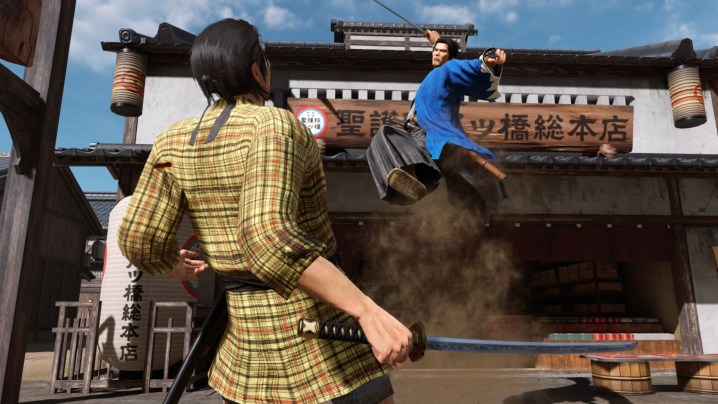
Thankfully, the basics of combat and the story being told are far from terrible, even if Ishin isn’t the prettiest or most fun Like a Dragon game you can play right now. As the Like a Dragon series continues to evolve and change, I hope that RGG Studios looks back at what it made here and takes the same strong creative spirit in future entries.
Even when they feel a bit dated, there’s nothing else quite like a game in the Like a Dragon series. That’s one thing I hope doesn’t change.
Like a Dragon: Ishin! was reviewed on Xbox Series X.
Editors' Recommendations
- Where to find every substory in Like a Dragon: Ishin!
- Valheim finally comes to Xbox next month with full crossplay
- Redfall’s May 2 release date revealed during Developer_Direct
- Xbox Series X tips and tricks: how to set up your new console
- S.T.A.L.K.E.R 2: Heart of Chernobyl: release date predictions, trailers, gameplay





